The fall of Kabul is being compared with the ‘fall of Saigon’ — a reference to 1975 when the capital of US-backed South Vietnam fell to Communist-ruled North Vietnam.
As thousands of Afghans, in a hope of catching a flight out, crowded onto the tarmac on Sunday, forcing US troops to fire shots into the air, many remembered the scenes from 46 year ago, of another US withdrawal, and another fall of a capital of the country that the western power had once entered and then exited, leaving it in utter chaos.
The Joe Biden-led US administration deployed 5000 troops to withdraw its diplomats and nationals from Kabul, as Taliban’s blitzkrieg reached the Afghan capital on Saturday.
The fall of Kabul is being compared with the ‘fall of Saigon’ — a reference to 1975 when the capital of US-backed South Vietnam fell to Communist-ruled North Vietnam two years after the withdrawal of US military presence of 19 years.
Saigon, which was later renamed as Ho Chi Minh City, fell on April 30, 1975, signalling the end of the Vietnam War, and the Communists consolidated their hold over the entire country in the next few months. Experts fear that the Taliban can do the same in Afghanistan in near future.

The Fall of Saigon, also known as the Liberation of Saigon by North Vietnamese, was the capture of Saigon, the capital of South Vietnam, by the People’s Army of Vietnam (PAVN) and the Viet Cong on 30 April 1975. The event marked the end of the Vietnam War and the start of a transition period to the formal reunification of Vietnam into the Socialist Republic of Vietnam.
Vietnam War and Fall of Saigon
The Vietnam War began in 1954 after North Vietnam’s General Vo Nguyen Giap defeated French colonial troops at Dien Bien Phu. The war, till it ended in 1975, saw American and Vietnamese casualties to the tune of 58,000 and 2,50,000 respectively, and ended up in the United States being thrown out of the country. General Giap defeated the Americans and the South Vietnamese at Saigon.
After Saigon fell, the newspapers and Television channels next day were filled with pictures of large groups of Americans, soldiers and civilians on the roof of the US Embassy. They all waited there to be rescued by military helicopters.
As US helicopters were overfilled and rose a few feet, many were seen clinging to its skids and jumping down on aircraft carriers before the helicopter could land.

Afghanistan War and Fall of Kabul
The war in Afghanistan began as a conflict following the 2001 United States invasion of Afghanistan when the United States and its allies drove the Taliban from power in order to deny Al-Qaeda a safe base of operations in Afghanistan. The move by the US and its allies came after the 9/11 terror attacks by the Al-Qaeda.
After the initial objectives were completed, a coalition of over 40 countries (including all NATO members) formed a security mission in the country called International Security Assistance Force (ISAF, succeeded by the Resolute Support Mission (RS) in 2014) of which certain members were involved in military combat allied with Afghanistan’s government. The war has mostly consisted of Taliban insurgents fighting against the Afghan Armed Forces and allied forces.
The US and its allies have reportedly suffered 3562 casualties, while Afghan security forces have seen more than 65000 casualties. Taliban, on the other hand, suffered more than 51,000 casualties, though there are no official numbers and experts say that real number could be higher.

However, after the US and its allies announced withdrawal from Afghanistan in 2021, a military offensive by the Taliban and allied militant groups against the government of Afghanistan and its allies began on 1 May 2021.
In just 3 months and 2 weeks, Taliban were on the gates of the country’s capital Kabul, as all major cities fell to the insurgents, with the government security forces putting up a little or no fight.
As Kabul fell, astoundingly similar scenes were observed at the Kabul airport, reminding people of the fall of Saigon.
As thousands of Afghans, scared of the Taliban rule, ran to the airport to flee, the US security forces had to fire in the air to control the crowd. According to report, three people have died at the airport after suffering bullet wounds. However, it has not been confirmed whether the bullets were fired by the US soldiers. After the chaos that engulfed the capital airport, reports said that the US had closed the Kabul Airport for commercial flights to speed up evacuation of its diplomats and nationals.
In one of the horrifying videos surfaced on Twitter, two civilians wrapped in the wheels of a Plane eager to leave Afghanistan can be seen falling down while taking off.
Very sad video
Two civilians wrapped in the wheels of a Plane eager to leave #Afghanistan can be seen falling down while taking off.#AfghanistanBurning #Kabul #KabulFalls @BBhuttoZardari @BakhtawarBZ @hyzaidi @AsadAToor @Xadeejournalist @Matiullahjan919 @MarianaBaabar pic.twitter.com/jMJK6DEoWm
— Raza Dharejo PPP (Official) (@RazaDharijo) August 16, 2021
US Rejects Comparison
The US secretary of state Antony Blinken, to defend the US’s mission in Afghanistan and attempt to hold back a tide of comparisons between the chaotic scenes unfolding in Kabul, told ABC’s This Week: “This is manifestly not Saigon.”
“We went into Afghanistan 20 years ago with one mission in mind, and that was to deal with the people who attacked us on 9/11, and that mission has been successful,” Blinken said.

As an independent media platform, we do not take advertisements from governments and corporate houses. It is you, our readers, who have supported us on our journey to do honest and unbiased journalism. Please contribute, so that we can continue to do the same in future.

